Linnea Tanner's Blog, page 11
September 18, 2024
Laura Rahme The Signare of Gorée #HistoricalMystery #HistoricalFiction #BlogTour #TheCoffeePotBookClub @cathiedunn
I‘m pleased to welcome Laura Rahme as the featured author in The Coffee Pot Book Club Blog Tour being held between September 12th – October 3rd, 2024. Laura Rahme is the author of the Historical Mystery / Historical Fiction, The Signare of Gorée, independently released by the author on 9th September 2024 (301pages).
Below are highlights of The Signare of Gorée, Laura Rahme’s author bio, and a guest post about the historical research of her book.

Tour Schedule Page: https://thecoffeepotbookclub.blogspot.com/2024/07/blog-tour-the-signare-of-goree-by-laura-rahme.html
HIGHLIGHTS: THE SIGNARE OF GORÉE
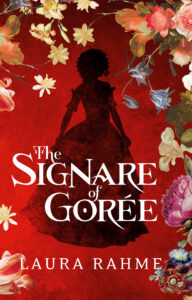 The Signare of Gorée
The Signare of Gorée
By Laura Rahme
Blurb:
1846. In the heat of West Africa, the French navy uncovers the corpses of two French soldiers. Inspector Maurice Leroux arrives at the island of Gorée. It seems death has come to this small colonial outpost off the Senegal coast, home to the prosperous mixed-blood women known as the signares.
The navy suspects that the Bambara people, emboldened by approaching emancipation, may be out for blood. While confronted by the locals’ strange magical beliefs, Maurice remains skeptical. Does malevolence play a part, or are these deaths accidental, brought upon by the brutality of nature in an island known as the white man’s grave?
But when murder strikes, it becomes clear that a killer is stalking Gorée.
Swept by a mystery unlike any he has known, Maurice meets Signare Angélique Aussenac. The proud métis, deserted by her wealthy Bordeaux lover, casts her spell upon Maurice.
But beyond the throbbing sounds of the tam-tams and the glittering signare soirées, danger lurks. Someone is watching. And the deaths go on.
Could the killer be one of the rich Bordeaux merchants? Or are they hiding among the powerful signares?
A historical mystery spanning France and Senegal, THE SIGNARE OF GORÉE explores a world of magic, murder, and passion.
Buy Links:
This title is available to read on #KindleUnlimited.
Universal Buy Link: https://books2read.com/u/4Nl7xz
AUTHOR BIO: LAURA RAHME

Laura Rahme is the author of seven historical novels. Born in Dakar, Senegal where she spent her early childhood, she moved to Australia at the age of ten. A graduate of two Honors degrees in Aerospace Engineering and Psychology, she has worked over two decades as an IT professional. Her greatest joy comes from travel, researching history, and penning historical mysteries. She now lives in France with her screenwriting husband.
Author Links:
Website: https://teranga-and-sun.blogspot.com/
Facebook: https://www.facebook.com/laurarahme.author/
Instagram: https://www.instagram.com/laurarahmegram/
Pinterest: https://www.pinterest.com.au/teranga/
Amazon Author Page: https://www.amazon.com/stores/Laura-Rahme/author/B008P7CF8K
Goodreads: https://www.goodreads.com/author/show/6449755.Laura_Rahme
GUEST POST: HIGHLIGHTS OF MY HISTORICAL RESEARCH

The Signare of Gorée: Highlights of My Historical Research
I doubt I could have gained the confidence to endeavor writing The Signare of Gorée without firsthand experience with the setting. It helped to have been born in Senegal and to have lived my early childhood gaining knowledge about the Senegalese and their culture. There are details about local traditions, values, clothing, food, and religious beliefs that I knew of intrinsically when I set out to write.
Given the novel takes place in 1840s Gorée, a period when the French were in possession of the island, French historical sources like the Annales Maritimes et Coloniales were particularly useful. The French side of my family also offered a wealth of genealogical material. From the 16th to the 19th century, my ancestors include ship captains and marine officers, and their lives contributed to my understanding of the world I was trying to paint. This was the easy part but there was still much work to do!
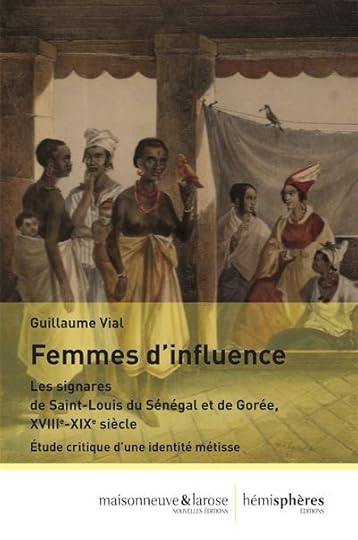 Femmes d’Influence by Guillaume Vial
Femmes d’Influence by Guillaume Vial
Publisher image for educational purposes
To begin, I was keen to discover more about the signares of Senegal and about slave-trading. One source that stood out was Professor Guillaume Vial’s fantastic book, Femmes d’influence : Les signares de Saint-Louis du Sénégal et de Gorée, XVIIIe-XIXe siècle (Women of influence: the signares of Saint-Louis of Senegal and of Gorée, 18th – 19th century). Published in 2019, it traces the history of the signares over the centuries, uncovering their origins, their culture, their commercial activities, their status, and details about their dress and relationships. Another book, and one that will forever haunt me, is Marcus Rediker’s The Slave Ship: A Human History. It draws from various fascinating historical sources, to give a poignant and harrowing depiction of all the actors of the so-called Middle Passage, their activities, and their brutal relationships. I cannot recommend it strongly enough.
Still on the topic of slavery was a book consisting of a collection of 1817-1819 diplomatic letters which included correspondence from Lord Castlereagh. These letters, while formal, convey disgust and a high moral stance as they relate ongoing illegal slave trading activities in Senegal despite the transatlantic trade ban. You can sense the outrage and shock that illegal slave trading activities elicited from that period onward.
To build the world for The Signare of Gorée, I lost myself in dozens of research papers whose subjects ranged from Lebou religious practices, Bambara plant usage, to partitions of property on Gorée. There was a certain eye-opening article on Rouen textile manufacturing that held my interest. It told of Rouen’s determination to produce cheaper fabrics that might be employed to trade for gold, ivory, and other riches from Senegambia. In fact, the locals of the African Coast were lovers of textiles, such that fabrics became a primary trade commodity.
My favorite part of the research was studying 19th century illustrations. These helped me glean a little about life in 19th century Gorée. It is a miracle we have these pictures at all. Some of them were created by François of Orléans, the Prince of Joinville. As a French officer, he traveled through West Africa in the late 1830s and early 1840s. Having the means for a quality education, he was a prolific artist, and his aquarelles are particularly evocative. Incidentally he was the brother of the Duke of Aumale, the prince who restored the Château of Chantilly to its former glory.
Other illustrators whose works helped to picture the signares and or who inspired my novel include, Gustave Boulanger (1824-1888), Stanislas Darondeau (1807-1842), Evremond de Bérard (1824-1881), Jules Gaildrau (1816-1898), Adolphe d’Hastrel (1805-1874), Edouard Auguste Nousveaux (1811-1848), and the métis priest, David Boilat (1814-1901).
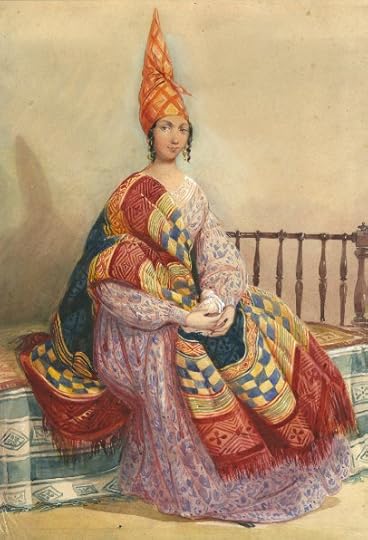
Signare by Stanislas Darondeau
Public domain image
Reading about these men’s biographies, one appreciates how dangerous any expedition to Gorée would have been for an artist in those days. Darondeau could have produced so much more art, but sadly on his return to Brest in Brittany, he died of a fever contracted in Gorée, at the mere age of thirty-four. Succeeding him as the designated illustrator for Senegal expeditions, was Nousveaux but he, too, did not fare well, contracting an illness in 1848 and dying in Saint-Louis. We can at least be grateful to these artful souls for venturing to Gorée and creating illustrations without which we could scarcely imagine the long vanished signares.
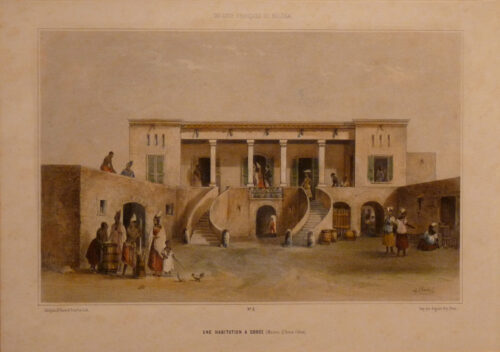
A house in Gorée. (The House of Anna Colas.)
Engraving by Adolphe d’Hastrel, circa 1845
Unmodified and sourced from Ji-Elle, under Creative Commons Attribution
Before concluding, I would like to share one of my favorite illustrations of Gorée. This is Adolphe d’Hastrel’s House of Anna Colas. It is here that my detective lodges during his stay on Gorée. Note that Hastrel labeled it as a villa, not at all as the “House of Slaves” which is the name by which it became known in the 20th century, coinciding with the dawn of tourism in Gorée. I loved this illustration so much I tried to bring it to life in my book, during a scene where Inspector Maurice Leroux awakes from his afternoon nap. I imagined him staying in the right-hand wing, where that man is standing at the balcony. It is a simple but delightful illustration, and I hope I gave it justice.

 Twitter: @cathiedunn
Twitter: @cathiedunn
Instagram & Threads: @thecoffeepotbookclub
Bluesky: @cathiedunn.bsky.social
September 16, 2024
Bradley John Ships of War—Murky Waters HistoricalFiction #NavalFiction #NavalAdventure #BlogTour #TheCoffeePotBookClub @cathiedunn
I‘m pleased to welcome Bradley John as the featured author in The Coffee Pot Book Club Blog Tour being held between September 16th – 20th, 2024. Bradley John is the author of the Naval Adventure Fiction, Ships of War — Murky Waters, released by Historium Press on 3rd September 2024 (460 pages).
Below are the highlights of Murky Waters, Bradley John’s author bio, and an excerpt from his book.

Tour Schedule Page: https://thecoffeepotbookclub.blogspot.com/2024/06/blog-tour-ships-of-war-murky-waters-by-bradley-john.html
HIGHLIGHTS: SHIPS OF WAR — MURKY WATERS

Ships of War — Murky Waters
by Bradley John
Blurb:
1791 — England’s cannon remain ever silent as her shipping is ruthlessly preyed upon, a detestable state of affairs, though soon to be remedied…
England is ill prepared, Europe is in turmoil and the French Revolution is readying to sweep across the continent. A tedious uneasy peace poises on a knife’s edge. Brittana rules the waves, yet as more and more ships mysteriously vanish, it is rightly thought an act of war. However, England needs more time, or all could be lost.
With war looming, Lieutenant Hayden Reginald Cooper, Royal Navy, awaits in Portsmouth braving a bitter cold winter with half pay, beached in a constant state of penury. With little prospects, little “interest” and no chance of promotion or advancement, he is the perfect choice for the Admiralty: unknown, unimportant and wholly dispensable.
As so it begins, a turbulent action-packed naval adventure within the murky waters preceding war, the French piracy soon to discover the grit of a lowly Lieutenant, one who has very little to lose…
Buy Link:
Universal Buy Link: https://books2read.com/u/br2gDZ
AUTHOR BIO: BRADLEY JOHN

Bradley John Tatnell (aka “Bradley John”) is an Australian novelist whose ancestry can be traced back to the Norman Conquest in England. His forbears lived mostly in Kent, Hertfordshire and the Isle of Thanet. Some were mariners and some were even of the aristocracy. His direct ancestors arrived in Australia soon after its colonisation in the late 1700’s, most of which were proud country folk. James Squire, a notable character in history, who arrived on the first fleet in 1788, was his (sixth) great grandfather.
Bradley John graduated from the Church of England Grammar School at age 16 and the Queensland University of Technology at age 19. His early life was spent mainly in the arena of law.
Bradley John has a love of all things ancient and historical, including golf, to which he plays with ye old hickory shafted clubs including the original heads from pre-1935. He also studies the ancient art of Korean sword, having attained master level. His love of language, in all its forms, now extends to the pursuit of conquering Hangul, the language of the Korean people.
Bradley John has been privately writing novels since 2003. “Ships of War — Murky Waters”, his first publication, births a series of naval adventure fiction intended to span the length of the French Revolutionary Wars. This of course is the much loved genre which includes the thundering Hornblower series by C.S. Forester, the Aubrey-Maturin series by Patrick O’Brian and the popular “Master and Commander” blockbuster by Peter Weir. Owing to Bradley John’s English heritage, no guesses are needed to determine which side the book’s heroes will sail upon…
Author Links:
Website: https://www.bradleyjohnauthor.com
Facebook: https://www.facebook.com/people/Bradley-John-Author/61555706665586
Instagram: https://www.instagram.com/bradley.john.author
EXCERPT: SHIPS OF WAR — MURKY WATERS

Chapter 10
Agamemnon snuck around the shoreline like an African cat slinking about a waterhole, waiting hungrily on its prey. They were in the shadow of Sheppey now, the sun rapidly descending almost directly behind them. The ship started to make way considerably, the bow nodding heavily in descent and ascent, determined to scythe deep the murk of the Channel. The jacks were not ignorant either of their captain’s cunning. He had been as slippery as an old hand nicking the rum. It would take a lookout of some quality to now spot Agamemnon running fine in the afternoon shadow with the sun squarely disappearing. It was a point of honour to serve with a captain who was no fool and how they buzzed as they weathered the speed of the ship making way. The far horizon deepened, finally falling dim. Underneath the flash of battle flickered haphazardly, Thor’s hammer sparking within a darkened cloud. They could hear the cannon fire now, much the same as a faint thunder breaking the distance on a stormy night. The jacks popped up their good ears, waiting and listening, some older hands counting the intervals to attest the cannon crews’ skill, others immediately insisting they were six pounders on one brig and eight pounders on the other.
Cooper took the time to settle his thoughts, play through the relevant and most likely scenarios. A British ship was under fire, running for their very lives. He was required to render immediate assistance, there was no other course, lest he enjoyed hanging. But he had not a full complement and there was an uncertainty in the crew, something to which he couldn’t shake. They were new and were yet to fight together as such. Some had not been aboard a ship for years. This wasn’t the prudence for which he and Nelson had painstakingly planned. Should he come up on the action and suddenly find a seventy-four, or a squadron of pirates, all could be lost. It was a good guess no pirate would wait around to take charge of a third rate with some four hundred men. No, indeed, they would be of a mind to just sink her and be done with it. And with that, Cooper would also be sunk, his career and livelihood abruptly at an end, that is should he somehow manage to even survive.

 Twitter: @cathiedunn
Twitter: @cathiedunn
Instagram & Threads: @thecoffeepotbookclub
Bluesky: @cathiedunn.bsky.social
August 21, 2024
Book Spotlight Return to the Eyrie Katerina Dunne #HistoricalFiction #MedievalFiction #MedievalHungary #BlogTour #TheCoffeePotBookClub @cathiedunn
I am pleased to spotlight the book, Return to the Eyrie, by Katerina Dunne in The Coffee Pot Book Club Blog Tour being held on August 1st – 22nd, 2024. Return to the Eyrie (Medieval Hungary Series) is a Historical Fiction (Medieval) / Historical Romance published by Historium Press on 30 April 2024 (404 pages).
Below are highlights of Return to the Eyrie and Katerina Dunne’s author bio.
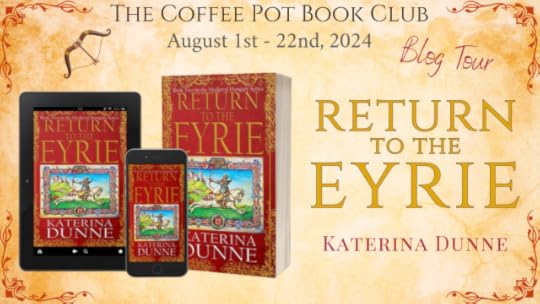
Tour Schedule Page: https://thecoffeepotbookclub.blogspot.com/2024/07/blog-tour-return-to-the-eyrie-by-katerina-dunne.html
HIGHLIGHTS: RETURN TO THE EYRIE
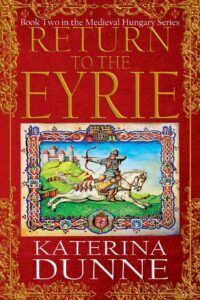
Return to the Eyrie
(Medieval Hungary
Series)
by Katerina Dunne
Blurb:
Honour, revenge, and the quest for justice.
Belgrade, Kingdom of Hungary, 1470:
Raised in exile, adolescent noblewoman Margit Szilágyi dreams of returning to her homeland of Transylvania to avenge her father’s murder and reclaim her stolen legacy. To achieve this, she must break the constraints of her gender and social status and secretly train in combat.
When the king offers her a chance at justice, she seizes it—even if it means disguising herself as a man to infiltrate the vultures’ nest that now occupies her ancestral ‘eyrie’.
Plagued by childhood trauma and torn between two passionate loves, Margit faces brutal battles, her murderous kin’s traps and inner demons on her quest for vengeance. Only by confronting the past can she reclaim her honour—if she can survive long enough to see it through.
Return to the Eyrie is an epic coming-of-age tale of a young woman’s unwavering pursuit of justice and destiny in 15th century Hungary.
Triggers: battle violence (moderate), love scenes (moderate), and character suffering from childhood trauma (molestation)
Buy Link:
Universal Buy Link: https://books2read.com/u/bz8gJL
AUTHOR BIO: KATERINA DUNNE
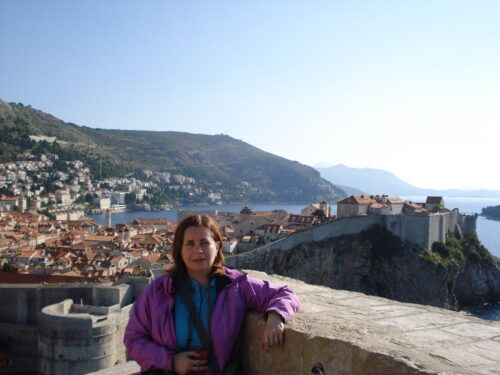
Katerina Dunne is the pen-name of Katerina Vavoulidou. Originally from Athens, Greece, Katerina has been living in Ireland since 1999. She has a degree in English Language and Literature from the University of Athens, an MA in Film Studies from University College Dublin and an MPhil in Medieval History from Trinity College Dublin.
Katerina is passionate about history, especially medieval history, and her main area of interest is 13th to 15th century Hungary. Although the main characters of her stories are fictional, Katerina uses real events and personalities as part of her narrative in order to bring to life the fascinating history of the medieval Kingdom of Hungary, a location and time period not so well-known to English-speaking readers.
Return to the Eyrie (published April 2024) is the second book in the Medieval Hungary series, a sequel to Lord of the Eyrie (published in February 2022).
Author Links:
Website (publisher): https://www.thehistoricalfictioncompany.com/hp-authors/katerina-dunne
Facebook: https://www.facebook.com/profile.php?id=100076818802721
LinkedIn: https://www.linkedin.com/in/katerina-vavoulidou-07962a85/
Amazon Author Page: https://www.amazon.com/stores/Katerina-Dunne/author/B09R4P733K
Goodreads: https://www.goodreads.com/author/show/22196953.Katerina_Dunne

 Twitter: @cathiedunn
Twitter: @cathiedunn
Instagram & Threads: @thecoffeepotbookclub
Bluesky: @cathiedunn.bsky.social
August 14, 2024
Jennifer Ivy Walker The Witch of the Breton Woods #HistoricalFiction #HistoricalRomance #FrenchResistance #Brittany #BlogTour #TheCoffeePotBookClub @bohemienneivy @cathiedunn
I‘m delighted to welcome Jennifer Ivy Walker as the featured author in The Coffee Pot Book Club Blog Tour being held between August 14th – September 4th, 2024. Jennifer Ivy Walker is the author of the Historical Romance / Romantic Suspense, The Witch of the Breton Woods, released by The Wild Rose Press on July 10, 2024 (163 pages).
Below are the highlights and the book trailer of The Witch of the Breton Woods, Jennifer Ivy Walker’s author bio, and an excerpt from her book.

Tour Schedule Page: https://thecoffeepotbookclub.blogspot.com/2024/07/blog-tour-the-witch-of-the-breton-woods-by-jennifer-ivy-walker.html
HIGHLIGHTS: THE WITCH OF THE BRETON WOODS

The Witch of the Breton Woods
by Jennifer Ivy Walker
Blurb:
Traumatized by horrors witnessed during the Nazi invasion of France, a young woman retreats to the dense Breton woods where she becomes a member of the clandestine French Resistance. When she finds a critically injured American paratrooper whose plane was shot down, she shelters the wounded soldier in her secluded cottage, determined to heal him despite the enormous risk.
Ostracized by villagers who have labeled her a witch, she is betrayed by an informant who reports to the Butcher—the monstrous leader of the local paramilitary organization that collaborates with the Germans. As the enemy closes in, she must elude the Gestapo while helping the Resistance reunite the American with his regiment and join the Allied Forces in the Battle of Brittany.
Can true love triumph against all odds under the oppressive Third Reich?
Triggers: sexually explicit scenes; graphic violence and language
Buy Link:
Universal Buy Link: https://books2read.com/u/mdAzww
BOOK TRAILER: THE WITCH OF THE BRETON WOODS
Trailer link: https://youtu.be/6A-VLgO7Aww?si=z6Mx_Mvncgfz2voP
AUTHOR BIO: JENNIFER IVY WALKER
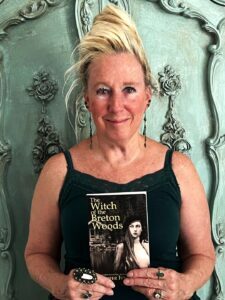
Jennifer Ivy Walker has an MA in French literature and is a former high school teacher and professor of French at a state college in Florida. Her novels encompass a love for French language, literature, history, and culture, incorporating her lifelong study, summers abroad, and many trips to France.
The Witch of the Breton Woods is heart-pounding suspense set during WWII in Nazi-occupied France, where a young woman in the French Resistance shelters and heals a wounded American soldier, hiding him from the Gestapo and the monstrous Butcher who are relentlessly hunting him.
Author Links:
Website Twitter Facebook LinkedIn Instagram
Pinterest Book Bub Amazon Author Page Goodreads
EXCERPT: THE WITCH OF THE BRETON WOODS
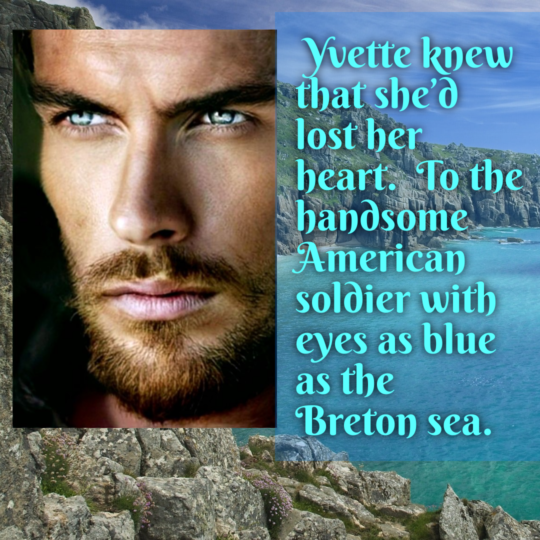
Beau would leave her in a few short weeks. To rejoin his regiment and return to battle. Neither of them knew if they’d even survive this damned war. Tomorrow might never come. But they did have today. And Yvette vowed that she wouldn’t make the same mistake twice.
He’d leave her, yes.
But with fond memories instead of bitter regret.
Life was ephemeral. Fragile. Fleeting. Love was a rare, precious gift. This time, she would grab the chance for happiness and seize the day.
Carpe diem.

 Twitter: @cathiedunn
Twitter: @cathiedunn
Instagram & Threads: @thecoffeepotbookclub
Bluesky: @cathiedunn.bsky.social
August 8, 2024
Constance Briones Try Before You Trust #HistoricalFiction #BiographicalFiction #LiteraryFiction #BlogTour #TheCoffeePotBookClub @cathiedunn
I‘m pleased to welcome Constance Briones as the featured author in The Coffee Pot Book Club Blog Tour being held between August 5th – 9th, 2024. Constance Briones is the author of the Historical Fiction, Try Before You Trust: To All Gentlewomen and Other Maids in Love, released by Historium Press on January 10, 2024 (eBook) / July (paperback) [286 pages].
Below are highlights of Try Before You Trust, the author bio of Constance Briones, and an excerpt from her book.

Tour Schedule Page: https://thecoffeepotbookclub.blogspot.com/2024/07/blog-tour-try-before-you-trust-by-constance-briones.html
HIGHLIGHTS: BEFORE YOU CAN TRUST
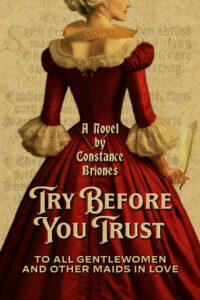 Before You Trust: To All Gentlewomen and Other Maids in Love
Before You Trust: To All Gentlewomen and Other Maids in Love
By Constance Briones
Blurb:
What if Taylor Swift found herself penning songs about love in Elizabethan England when women were required to be chaste, obedient, and silent?
Isabella Whitney, an ambitious and daring eighteen-year-old maidservant turned poet, sets out to do just that. Having risked reputation and virtue by allowing her passions for her employer’s aristocratic nephew to get the better of her, Isabella Whitney enters the fray of the pamphlet wars, a scurrilous debate on the merits of women.
She’s determined to make her mark by becoming the first woman to write a poem defending women in love, highlighting the deceptive practices of the men who woo them. Her journey to publication is fraught with challenges as she navigates through the male-dominated literary world and the harsh realities of life in sixteenth-century London for a single woman.
Loosely based on the life of Elizabethan poet Isabella Whitney, this is a compelling tale of a young woman’s resilience and determination to challenge the status quo and leave her mark in a world that was not ready for her.
Buy Link:
Universal Buy Link: https://books2read.com/u/3Jly0J
AUTHOR BIO: CONSTANCE BRIONES
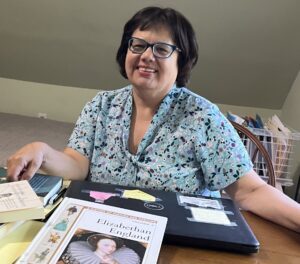
Constance Briones has a Master’s in Woman’s History, which informs her writing.
She first learned about the subject of her debut historical fiction novel, the sixteenth-century English poet Isabella Whitney, while doing research for her thesis on literacy and women in Tudor England. Isabella Whitney’s gusty personality to defy the conventions of her day, both in her thinking and actions, impressed Constance enough to imagine that she would make a very engaging literary heroine.
As a writer, Constance is interested in highlighting the little-known stories of women in history. She is a contributing writer to Historical Times, an online magazine. When not writing, she lends her time as an educational docent for her town’s historical society.
She contently lives in Connecticut with her husband and Maine coon sibling cats, Thor and Percy.
Author Links:
Facebook: www.facebook.com/constancebrionesauthor
LinkedIn: www.linkedin.com/in/constance-briones-a55a9168
Pinterest: www.pinterest.com/constancebrionesauthor
Amazon Author Page: www.amazon.com/stores/author/B0CPX8T7CB/about
EXCERPT−BEFORE YOU CAN TRUST:TO ALL GENTLEWOMEN AND OTHER MAIDS IN LOVE

“I have a fine collection of books suitable for your training here. Books that will reinforce the virtues of womanhood and housewifery skills. What say you? Are they of interest to you?”
My disappointment caused a surge of resentment to well inside me. Nay, they are not. I have a hunger to read books that are deemed unsuitable for our sex. Do you really believe that women need men to control what we read because of our weak nature? That we will be unduly influenced by romantic tales, leading us astray from the path of virtue? I don’t believe that –no matter how vigorously the church fathers preach it from their pulpits.
Zounds! I wish I had said that. Instead, inculcated by the teachings of my mother and father, I followed proper decorum. “And the reading of scripture is also important, my lady.”
Her smile became more inviting. “How is your hand with the needle, Isabella?”
The needle — how I hated it. Did she expect me to devote the little leisure time I would have to needlework and not read nor write poetry? I didn’t wince but smiled, “Quite competent, my lady.”
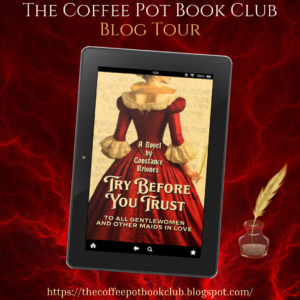
 Twitter: @cathiedunn
Twitter: @cathiedunn
Instagram & Threads: @thecoffeepotbookclub
Bluesky: @cathiedunn.bsky.social
August 2, 2024
Barnes & Noble Book Fair Briargate Colorado Springs Aug 4 @BN @BNBriargate @CoGreatAuthors @judithbriles #Colorado #Books #gifts #Weekend #BookReaders
Join Local Colorado Authors at the
Barnes & Noble Book Fair
Briargate Colorado Springs
Perfect for Summer Reading!
I’ll be joining other local bestselling and award-winning AuthorYou authors at the Barnes & Noble Book Fair, 1565 Briargate Blvd, Colorado Springs, CO 80920, to sign books from 10:00 am to 5:00 pm. Books and other store merchandise purchased by visitors in the store on Sunday will generate a donation to the Aspiring Authors Scholarships that will be awarded by the Colorado Authors’ Hall of Fame on September 16, 2024.

The book signing event will feature local authors of all genres including children’s books, YA, inspiration, thriller, historical fiction, fantasy, memoirs, self-help and much more. Click Colorado Authors Hall of Fame to learn more about the Aspiring Authors Scholarships.
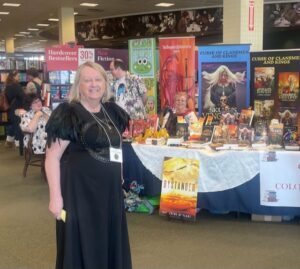


July 29, 2024
Carolyn Hughes Fortune’s Wheel Audiobook #HistoricalFiction #HistoricalRomance #MedievalEngland #BlogTour #TheCoffeePotBookClub @writingcalliope @cathiedunn @alexleeaudio
I‘m delighted to feature Carolyn Hughes in The Coffee Pot Book Club Audiobook Blog Tour being held between July 30th – August 1st, 2024. Carolyn Hughes is the author and Alex Lee is the audiobook narrator of the Historical Fiction, Fortune’s Wheel (The Meonbridge Chronicles Book 1), released by the author on 22 April 2024 (11 hours and 54 minutes).
Below are highlights of Fortune’s Wheel, author bio for Carolyn Hughes, and a snippet from her audiobook.

Tour Schedule Page: https://thecoffeepotbookclub.blogspot.com/2024/06/blog-tour-fortunes-wheel-audiobook-by-carolyn-hughes.html
HIGHLIGHTS: FORTUNE’S WHEEL

Fortune’s Wheel
(The Meonbridge Chronicles Book 1)
By Carolyn Hughes
Audiobook Narrator: Alex Lee
Blurb:
How do you recover from the havoc wrought by history’s cruellest plague?
It’s June 1349. In Meonbridge, a Hampshire manor, many have lost their lives to the Black Death, among them Alice atte Wode’s beloved husband and Eleanor Titherige’s widowed father. Even the family of the manor’s lord and his wife, Margaret de Bohun, has not entirely escaped.
But, now the plague has passed, the people of Meonbridge must work together to rebuild their lives. However, tensions mount between the de Bohuns and their tenants, as the workers realise their new scarceness means they can demand higher wages and dictate their own lives. When the tensions deepen into violence and disorder, and the men – lord and villagers alike – seem unable to find any resolution, the women – Alice, Eleanor and Margaret – must step forward to find a way out of the conflict that is tearing Meonbridge apart.
Buy Links:
This title/series is available to read on #KindleUnlimited.
Universal Buy Link: https://books2read.com/u/3LL1d1
Audible Links:
UK: https://www.audible.co.uk/pd/Fortunes-Wheel-Livre-Audio/B0D2FKPQN4
US: https://www.audible.com/pd/Fortunes-Wheel-Audiobook/B0D2FMT3QG
AUTHOR BIO: CAROLYN HUGHES

Carolyn Hughes has lived much of her life in Hampshire. With a first degree in Classics and English, she started working life as a computer programmer, then a very new profession. But it was technical authoring that later proved her vocation, word-smithing for many different clients, including banks, an international hotel group and medical instruments manufacturers.
Although she wrote creatively on and off for most of her adult life, it was not until her children flew the nest that writing historical fiction took centre stage. But why historical fiction? Serendipity!
Seeking inspiration for what to write for her Creative Writing Masters, she discovered the handwritten draft, begun in her twenties, of a novel, set in 14th century rural England… Intrigued by the period and setting, she realised that, by writing a novel set in the period, she could learn more about the medieval past and interpret it, which seemed like a thrilling thing to do. A few days later, the first Meonbridge Chronicle, Fortune’s Wheel, was under way.
Six published books later (with more to come), Carolyn does now think of herself as an Historical Novelist. And she wouldn’t have it any other way…
Author Links:
Website: https://carolynhughesauthor.com
Twitter: www.x.com/writingcalliope
Facebook: www.facebook.com/CarolynHughesAuthor
Bluesky: https://bsky.app/profile/carolynhughes.bsky.social
Book Bub: https://www.bookbub.com/authors/carolyn-hughes
Amazon Author Page: https://www.amazon.co.uk/stores/Carolyn-Hughes/author/B01MG5TWH1
Goodreads: https://www.goodreads.com/author/show/16048212.Carolyn_Hughes
AUDIO SNIPPET: FORTUNE’S WHEELhttps://www.linneatanner.com/wp-content/uploads/2024/07/FW-Trailer-Margaret.mp4

Twitter: @cathiedunn
Instagram & Threads: @thecoffeepotbookclub
Bluesky: @cathiedunn.bsky.social
July 28, 2024
Author Interview Eric Schumacher Riddle of the Gods #NorseHistoricalFiction #HistoricalAdventure #BookReview #Vikings @DarkAgeScribe
It’s my pleasure to welcome Eric Schumacher, best-selling author of the Olaf’s Saga series. I became acquainted with Eric’s work when I voluntarily reviewed his novel, War King (Hakon’s Saga Book 3), for the Historical Novel Society in 2018. Ever since then, I’ve been an avid follower of Eric Schumacher and have read every book in his most recent series, Olaf’s Saga. What makes his stories rise above others in the Viking Age are the engaging characters and vivid details of the Norse culture.
Eric graciously accepted my invitation to interview him after I read and reviewed his most recent Norse Historical Fiction / Historical Adventure novel, Riddle of the Gods (Olaf’s Saga Book 4) that was released by Bodn Books on March 25th, 2024 (280 pages)
Below are highlights of Riddle of the Gods, Eric Schumacher’s author bio, his interview, and my 5-star review of his compelling novel.
HIGHLIGHTS: RIDDLE OF THE GODS
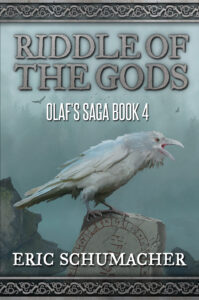
Riddle of the Gods
(Olaf’s Saga Book 4)
By Eric Schumacher
Blurb:
Riddle of the Gods is the riveting fourth novel in the best-selling series chronicling the life and adventures of one of Norway’s most controversial kings, Olaf Tryggvason.
It is AD 976. Olaf Tryggvason, the renegade prince of Norway, has lost his beloved wife to a tragedy that turns the lords of the land he rules against him. With his family gone and his future uncertain, Olaf leaves his realm and embarks on a decades-long quest to discover his course in life. Though his journey brings him power and wealth, it is not until he encounters the strange man in the streets of Dublin that his path to fame unfolds. And in that moment, he is forced to make a choice as the gods look on – a choice that could, at worst, destroy him and at best, ensure his name lives on forever.
Buy Links:
This book is available on #KindleUnlimited.
Universal Buy Link: https://mybook.to/Riddleofthegods
OLAF’S SAGA
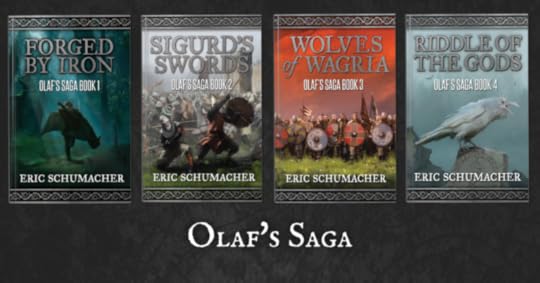
Olaf’s Saga is available on Kindle Unlimited
Amazon Buy Link for Olaf’s Saga: https://mybook.to/olafssaga
AUTHOR BIO: ERIC SCHUMACHER

Eric Schumacher is a historical fiction author of multiple best-selling novels set in the Viking Age. From a young age, Schumacher was drawn to books about medieval kings and warlords and was fascinated by their stories and the turbulent times in which they lived. It is a fascination that led to the publication of his first novel, God’s Hammer, in 2005, and many subsequent novels thereafter.
Schumacher now resides in Santa Barbara, CA with his wife and two children and is busy working on his next novel.
Social links:
Website: www.ericschumacher.net
Twitter: https://twitter.com/DarkAgeScribe
Facebook: https://www.facebook.com/EricSchumacherAuthor
Book Bub: https://www.bookbub.com/profile/eric-schumacher
Amazon Author Page: https://author.to/EricSchumacher
Goodreads: https://www.goodreads.com/author/show/399517.Eric_Schumacher
AUTHOR INTERVIEW: ERIC SCHUMACHER

1. Can you tell something about yourself and how you became an author?
I was born in Los Angeles in 1968, and while I consider myself to be a “Southern Californian” who was raised near (and could never live too far from) the sea, I also love to travel, love history, and love stories. My writing, I suppose, is an amalgamation of all of those things.
I’ve been a writer since elementary school. I was drawn to assignments that required writing rather than memorizing names, dates, and formulas. As early as the third grade, I’d come home from school to write my own stories. Strangely, though, I never considered writing as a “career.” It wasn’t until I was in graduate school for business (and studying for a horrible economics test) that the thought of writing as a profession occurred to me. That very day, I went home and started writing what was to become God’s Hammer, my very first book. The rest, as they say, is history.
2. Would you provide an overview of each novel in Olaf’s Saga.
At its core, Olaf’s Saga tells the battle-torn and gut-wrenching story of Olaf Tryggvason’s birth, trials, and rise to the throne of his native Norway. It is also the story of two close friends – Olaf and Torgil – who grow into something more like brothers through their shared adventures. The first book, Forged by Iron, sees Olaf and Torgil survive the brutality of slavery after being driven from their homeland. In the second book, Sigurd’s Swords, the two friends grow into men on the battle-scarred fields of Kyivan Rus’ (now Belarus, Ukraine, and Russia) as the kingdom’s leader, Sviatoslav, seeks to expand his power and his wealth. When Sviatoslav’s favor of Olaf fades, the young veteran leaves Rus’ in Wolves of Wagria, and with Torgil by his side, seeks his fame on the battlefields of a small Slavic kingdom known as Wagria (now Hostein in Germany). Olaf’s wife dies in Ridde of the Gods, and Olaf turns to raiding to salve his sorrow. That is, until a chance encounter with a priest in Ireland shows him his path to fame. While the path proves fruitful for Olaf, it is a path Torgil cannot follow, setting the stage for the final book in the series.
3. What inspired you to write about the legendary King Olaf Tryggvason in the Olaf’s Saga series?
King Olaf Tyrgvvason is a fascinating character. Many of the ancient texts paint him not only as a larger-than-life Viking but as a Christian hero. More modern historians (and countrymen) tend to view him as a villain and traitor. That is to say, he is complicated, tainted, imperfect, and yet somehow, charismatic. It was that complexity that drew me to him originally and that still fascinates me today. His history raised questions I yearned to answer. Was he always a villain or did he morph into that? If his wickedness grew, how did it grow, when did it grow, and why?
The other aspect that drew me to Olaf’s story was the vast ground Olaf covered in his life. He spent time in most of the known Viking world and his life would allow me to investigate and write about those places. I’ve loved diving into each of those settings as a backdrop to Olaf’s life.
4. Why did you choose to tell King Olaf’s story from the perspective of his loyal companion and protector, Torgil? Was Torgil mentioned in the Norse sagas along with Olaf?
Given the complexity of his character, I saw the dangers of writing the story from Olaf’s perspective. He would, of course, see himself as a hero, which I felt would be too one-sided and would not offer the chance to tell a fuller story. I wanted to draw out his complexity. Hence, I chose to write his story from the perspective of his friend, Torgil – someone who was capable of seeing both the good and the bad in Olaf. Torgil is mentioned briefly in Olaf’s original saga as being with Olaf when he and his mother escaped Norway, but he is not mentioned thereafter. Still, if he did exist, and did accompany Olaf on his many adventures, who better to have as the biographer of Olaf’s life?
5. How important is it to have your facts right and are there any instances when you bend history to fit your story?
It is important to me to get the facts as correct as I can. I want the history to be believable, and for people who know the history to find as much satisfaction in my story as those who don’t know the history. For that reason, I spend a lot of time researching and doing my best to get things right.
That said, much of Olaf’s history was recorded decades, and even centuries, after his existence, and is therefore not entirely reliable. Given that, I do my best to piece together the known history of the time and rely on plausibility for the rest. I ask myself questions such as, Could something have happened? Is it believable? Would it make sense for the time?
A good example of this can be found in Wolves of Wagria. There has been much debate as to Olaf’s location after he leaves Gardariki. The general understanding is that he served in the royal court of what is today Poland. But for many reasons, Poland made little sense. As this was central to the setting of the book and the plot, I scoured historical sources for more information. I eventually found a research article that offered a different – and very plausible – location for Olaf that made more sense historically and to my book. The research article has not been proven as true, but it worked for the story, so I used it.
6. What is your favorite quote from one of your books in the Olaf’s Saga series?
“Oaths are like iron, Torgil. You cannot break them.”
So says Torgil’s father to Torgil in the very first book. It is this idea that is the foundation of the entire series.
7. Can you give novice writers some tips (do’s/don’ts)?
Keep writing and don’t stop. Even when you think your words are garbage, don’t stop. Even when you spend hours staring at a blank screen and you only get a few words written, come back the next day and try again. The more you write, and the longer you write, the better you’ll get. And remember, even seasoned writers have bad days.
It may seem obvious, but put your best book forward. Your book is your product and is a reflection of your talent, so make sure the story and the grammar are thoroughly edited. Have readers beyond friends and family read it and provide feedback. I also send my book to readers who know Viking history. Having their historical feedback has been invaluable.
Ask for help. My experience has been that writers are always willing to help fellow writers. So if you need direction, or have a question, don’t be afraid to reach out and ask.
8. What are your future plans as an author?
My immediate plan is to finish book five of the saga, which will also put an end to the saga. It’s an end I look forward to and also fear because, quite frankly, I don’t know what is next. I may have more Viking tales in my future, but I’m also yearning to tell the history of different places, times, and peoples. So we’ll see!
BOOK REVIEW: RIDDLE OF THE GODS
 Riddle of the Gods: A Viking Age Novel by Eric Schumacher
Riddle of the Gods: A Viking Age Novel by Eric Schumacher
My rating: 5 of 5 stars
The clash between Christian religion and the Norse pagan beliefs adds another layer of conflict in the epic Norse adventure and action Riddle of the Gods—the fourth book in the Olaf’s Saga series. The Viking-age series is based on the legendary Olaf Tryggvason, King of Norway. The story is told from the first-person perspective of Torgil, Olaf’s companion. In the previous three books of the series, Torgil has sacrificed almost everything to fulfill his vow to protect his king.
The tale continues in 976 A.D. when Olaf tragically loses his pregnant wife, Queen Geira, in Wagria and nobles turn against him. Torgil follows Olaf on his decades-long quest to seek fortune and fame elsewhere. Olaf’s destiny dramatically changes when he encounters a disheveled priest in the streets of Dublin who declares: “Unlike the others who have come before you, you will become a renowned king and do celebrated deeds. Many men will you bring to the new faith through baptism … but before you possess those riches, you will be wounded almost to death by your own men and carried upon a shield to safety.” The prophecy comes true. Olaf miraculously heals in seven days from his wounds and converts to Christianity. He demands the same conversion from his warriors. Torgil, a strong believer in the Norse pagan gods, risks losing Olaf’s patronage if he doesn’t adopt the Christian religion.
Author Eric Schumacher has masterfully woven another conflict into the Viking saga: Christian dogma challenging traditional Nordic beliefs. The riveting battle scenes vividly play out in your mind like the previous books in the series. Yet, Torgil’s internal struggle to choose between his core values and duty to his king is as heart-wrenching as the combats. To truly understand the essence of Olaf and Torgil up to this point, I suggest you read the previous books in the series that explore universal themes of political corruption, love vs. duty, betrayal, and friendship. The books in Olaf’s Saga capture the turmoil of the Viking culture collapsing under the threats of warfare, Christian religion, and internal divisions. It is an addictive series akin to Bernard Cromwell’s The Last Kingdom, conveying the rise of kings and nations during the medieval period. Extra bonuses in the books include regional maps and a glossary of Viking terms used in the narrative.
Riddle of the Gods continues the epic saga of King Olaf and his closest companions searching for their destinies in the brutal Middle Ages world steeped with warfare, political intrigue, and betrayal. I highly recommend this multi-layered Norse adventure and action for its memorable characters, riveting battle scenes, and thought-provoking themes that will resonate in your mind long after you have finished reading the book.
July 27, 2024
Skull’s Vengeance Audiobook Reviewer’s Choice Award #AudioBookReviewer #AudioBookAward #books #audiobooks #booklover #historicalfantasy.
I am excited to announce that the audiobook of Skull’s Vengeance (Book 4 Curse of Clansmen and Kings) received the Audiobook Reviewer’s Choice Award. A special thank you is extended to the two narrators, Scott Ellis and Heidi Housh, who were commended by the reviewer for capturing the essence of each character.
Below are the completed review of Skull’s Vengeance, highlights of the audiobook, and snippets from the audiobook.
REVIEW: SKULL’S VENGEANCE
Intriguing Celtic Epic!
In this epic tale, Catrin and Marcellus reunite. They are both engaged in a deadly game to protect their love and ensure the survival of Catrin’s Clan and way of life. Alliances will form and break, battles will rage, and death will follow.
The author, Linnea Tanner, accurately captures and infuses her historical narratives with Celtic romance, action-filled adventure, and political intrigue of Ancient Rome and Britannia. Her characters are richly detailed, fully developed, and authentic to the narrative. It is evident in her narrative that she has extensively researched the customs and culture as well as figures of this period. The dialogue is authentic as well and keeps the narrative flowing smoothly. She immerses the listener into the narrative immediately and fully. The plot twists are surprising and well-executed!
The narrators, Scott Ellis and Heidi Housh, do a magnificent job of capturing the essence of each character. Their performances alternate yet blend smoothly and flawlessly. They each speak clearly, and their delivery styles allow the listener to deepen their immersion into the narrative. As a team, Ellis and Housh work well together.
I have had the pleasure of reading her first three novels in written form and the audio of this book is equally as captivating as her earlier books! This is an excellent book/series to pick up and enjoy! I highly recommend this book.
There were no issues with the quality or production of this audiobook.
Link to Review: https://www.audiobookreviewer.com/sku...
HIGHLIGHTS: SKULL’S VENGEANCE
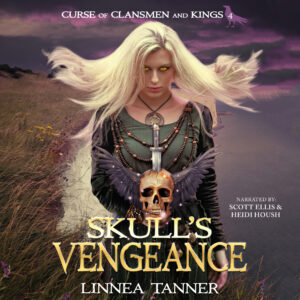
Skull’s Vengeance
(Book 4 Curse of Clansmen and Kings)
by Linnea Tanner
Narrated by Scott Ellis and Heidi Housh
Blurb:
A Celtic warrior queen must do the impossible—defeat her half-brother, a sorcerer, and claim the throne. But to do so, she must learn how to strike vengeance from her father’s skull.
AS FORETOLD BY HER FATHER in a vision, Catrin has become a battle-hardened warrior after her trials in the Roman legion and gladiatorial games. She must return to Britannia and pull the cursed dagger out of the serpent’s stone to fulfill her destiny. Only then can she unleash the vengeance from the ancient druids to destroy her evil half-brother, the powerful sorcerer, King Marrock. Always two steps ahead and seemingly unstoppable, Marrock can summon destructive natural forces to crush any rival trying to stop him and has charged his deadliest assassin to bring back Catrin’s head.
To have the slightest chance of beating Marrock, Catrin must forge alliances with former enemies, but she needs someone she can trust. Her only option is to seek military aid from Marcellus—her secret Roman husband. They rekindle their burning passion, but he is playing a deadly game in the political firestorm of the Julio-Claudian dynasty to support Catrin’s cause.
Ultimately, to defeat Marrock, Catrin must align herself with a dark druidess and learn how to summon forces from skulls to exact vengeance. But can she and Marcellus outmaneuver political enemies from Rome and Britannia in their quest to vanquish Marrock?
Universal Buy Link: https://books2read.com/Skulls-Vengeance-Book4
Skull’s Vengeance Prologue (Marrock’s Point of View)
Skull’s Vengeance Chapter 1 (Catrin’s Point of View)

July 22, 2024
Book Review The Agincourt King Mercedes Rochelle #TheAgincourtKing #HenryV #Agincourt #HistoricalFiction #Plantagenet #BlogTour #TheCoffeePotBookClub @authorRochelle @cathiedunn
It is my pleasure to feature author Mercedes Rochelle again in The Coffee Pot Book Club Blog Tour, being held between July 2nd – 23rd, 2024. She is the author of the Historical Fiction, The Agincourt King (The Plantagenet Legacy Book 5), that was published on April 8th, 2024 by Sergeant Press (260 pages).
Below are highlights of The Agincourt King, Mercedes Rochelle’’s author bio, and my 5-star review of her meticulously researched book.
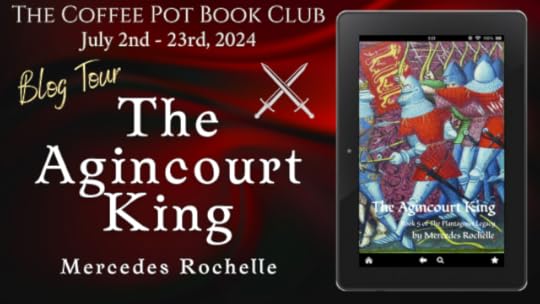
Tour Schedule Page: https://thecoffeepotbookclub.blogspot.com/2024/05/blog-tour-the-agincourt-king-by-mercedes-rochelle.html
HIGHLIGHTS: THE AGINCOURT KING
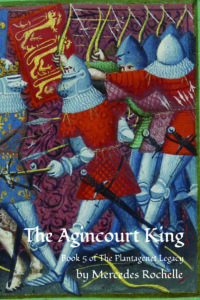
The Agincourt King
(The Plantagenet Legacy Book 5)
By Mercedes Rochelle
Blurb:
From the day he was crowned, Henry V was determined to prove the legitimacy of his house. His father’s usurpation weighed heavily on his mind. Only a grand gesture would capture the respect of his own countrymen and the rest of Europe. He would follow in his great-grandfather Edward III’s footsteps, and recover lost territory in France.
Better yet, why not go for the crown? Poor, deranged Charles VI couldn’t manage his own barons. The civil war between the Burgundians and Armagnacs was more of a threat to his country than the English, even after Henry laid siege to Harfleur. But once Harfleur had fallen, the French came to their senses and determined to block his path to Calais and destroy him.
By the time the English reached Agincourt, they were starving, exhausted, and easy pickings. Or so the French thought. Little did they reckon on Henry’s leadership and the stout-hearted English archers who proved, once again, that numbers didn’t matter when God was on their side.
Buy Links:
This title is available to read on #KindleUnlimited.
Universal Buy Link: https://books2read.com/u/mq70Ze
AUTHOR BIO: MERCEDES ROCHELLE
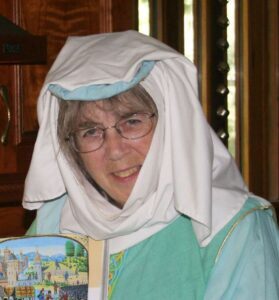
Mercedes Rochelle is an ardent lover of medieval history, and has channeled this interest into fiction writing. Her first four books cover eleventh-century Britain and events surrounding the Norman Conquest of England. The next series is called “The Plantagenet Legacy” and begins with the reign of Richard II.
She also writes a blog: www.HistoricalBritainBlog.com to explore the history behind the story. Born in St. Louis, MO, she received by BA in Literature at the Univ. of Missouri St.Louis in 1979 then moved to New York in 1982 while in her mid-20s to “see the world”. The search hasn’t ended!
Today she lives in Sergeantsville, NJ with her husband in a log home they had built themselves.
Author Links:
Website: https://mercedesrochelle.com/
Blog: https://historicalbritainblog.com/
Twitter / X: https://x.com/authorrochelle
Facebook: https://www.facebook.com/mercedesrochelle.net
Book Bub: https://www.bookbub.com/authors/mercedes-rochelle
Amazon Author Page: https://www.amazon.com/stores/Mercedes-Rochelle/author/B001KMG5P6
Goodreads: https://www.goodreads.com/author/show/1696491.Mercedes_Rochelle
BOOK REVIEW: THE AGINCOURT KING
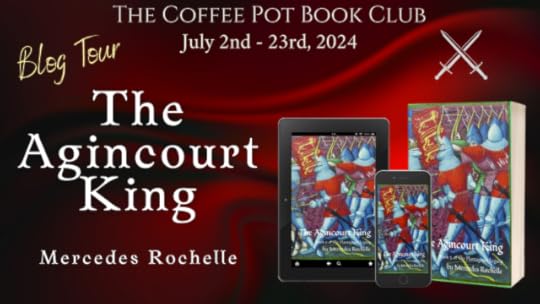
The battled-hardened warrior king, Henry V, is determined to create his legacy in the Medieval Historical Fiction, The Agincourt King (The Plantagenet Legacy Book 5). Impetuous and fiery-tempered, King Henry V puts on a mask of piety even though his cruelty could manifest at any moment. He believes God has destined him to regain lost territories in France and thus decides to reignite the Hundred Years’ War. The time seems right in 1414. France is distracted by its internal conflicts and its weak king. But as Henry V is ready to embark to France, he discovers the Cambridge Plot to replace him with Edmund Mortimer as king. He exacts justice with an iron fist on the treasonous nobles, then sets sail to demonstrate his military prowess with decisive victories in France, despite the odds.
Author Mercedes Rochelle demonstrates her impeccable research in this historical biographical fiction. Various points of view were sometimes used in a chapter to paint a broad stroke of the political intrigue and the battle scene. Scenes told from the first-perspective perspective of Henry’s younger brother, Humphrey, Duke of Gloucester, provide the greatest insight into King Henry V as a historical figure. His inner circle of nobles stays clear of him when his temper flares, but they demonstrate absolute allegiance to protect him in battle. Likewise, Henry V shows respect and generosity to those most loyal to him. He inspires his army with his leadership qualities and fights with his soldiers to win decisive victories despite the odds.
This is a plot-driven novel, emphasizing the political intrigue behind the campaigns that Henry V undertook. I felt as if I were in the midst of battle at Agincourt. The points of view change, giving the reader a sense of what is happening at various locations in the conflict. Military tactics switch suddenly, depending on unexpected changes in the momentum of the clash. Hardship and cruelty of war resonate from one battle scene to another. Soldiers suffering from disease and malnutrition fight fiercely to protect their comrades. Prisoners of war held for ransom are sometimes sacrificed when the promise of victory turns the tide. A list of characters and maps are additional bonuses.
I highly recommend The Agincourt King for its intriguing political intrigue, cinematic battle scenes, and historical detail of the medieval era in Europe.
 Twitter: @cathiedunn
Twitter: @cathiedunn
Instagram & Threads: @thecoffeepotbookclub
Bluesky: @cathiedunn.bsky.social



